Geomechanics for Unconventional Reservoirs: A Case Study
VerifiedAdded on 2023/06/10
|31
|8186
|488
Project
AI Summary
This project investigates the application of geomechanics in unconventional reservoirs to optimize hydraulic fracturing for field development. The study begins with an introduction to conventional and unconventional reservoirs, highlighting the importance of geomechanical properties in predicting fracture propagation and understanding stimulated areas. A literature review provides background on unconventional resources, shale characteristics, and the role of geomechanics in hydrocarbon production. The methodology includes data inventory, stress analysis, and structural modeling using CMG software, with a case study of the Niobrara Formation. The project aims to analyze geomechanical properties to design efficient hydraulic fracturing, securing energy demands from unconventional sources. The results demonstrate how geomechanical properties aid in predicting rock reactions, wellbore stability, and reducing drilling risks. The project includes a comprehensive analysis of unconventional reservoir geomechanics, including stress analysis, CMG modeling, and hydraulic fracturing design.

Geomechanics for Unconventional Reservoirs
Paraphrase This Document
Need a fresh take? Get an instant paraphrase of this document with our AI Paraphraser
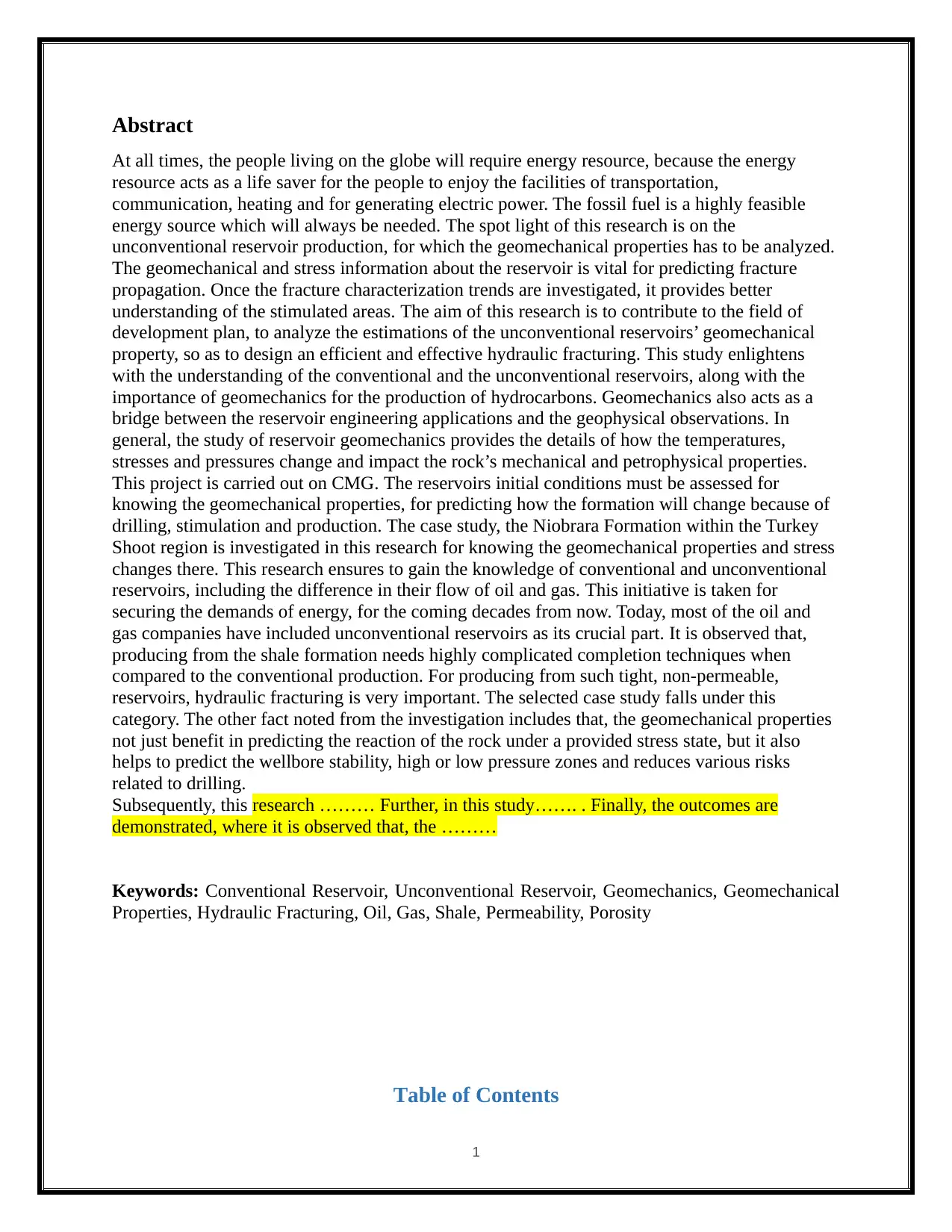
Abstract
At all times, the people living on the globe will require energy resource, because the energy
resource acts as a life saver for the people to enjoy the facilities of transportation,
communication, heating and for generating electric power. The fossil fuel is a highly feasible
energy source which will always be needed. The spot light of this research is on the
unconventional reservoir production, for which the geomechanical properties has to be analyzed.
The geomechanical and stress information about the reservoir is vital for predicting fracture
propagation. Once the fracture characterization trends are investigated, it provides better
understanding of the stimulated areas. The aim of this research is to contribute to the field of
development plan, to analyze the estimations of the unconventional reservoirs’ geomechanical
property, so as to design an efficient and effective hydraulic fracturing. This study enlightens
with the understanding of the conventional and the unconventional reservoirs, along with the
importance of geomechanics for the production of hydrocarbons. Geomechanics also acts as a
bridge between the reservoir engineering applications and the geophysical observations. In
general, the study of reservoir geomechanics provides the details of how the temperatures,
stresses and pressures change and impact the rock’s mechanical and petrophysical properties.
This project is carried out on CMG. The reservoirs initial conditions must be assessed for
knowing the geomechanical properties, for predicting how the formation will change because of
drilling, stimulation and production. The case study, the Niobrara Formation within the Turkey
Shoot region is investigated in this research for knowing the geomechanical properties and stress
changes there. This research ensures to gain the knowledge of conventional and unconventional
reservoirs, including the difference in their flow of oil and gas. This initiative is taken for
securing the demands of energy, for the coming decades from now. Today, most of the oil and
gas companies have included unconventional reservoirs as its crucial part. It is observed that,
producing from the shale formation needs highly complicated completion techniques when
compared to the conventional production. For producing from such tight, non-permeable,
reservoirs, hydraulic fracturing is very important. The selected case study falls under this
category. The other fact noted from the investigation includes that, the geomechanical properties
not just benefit in predicting the reaction of the rock under a provided stress state, but it also
helps to predict the wellbore stability, high or low pressure zones and reduces various risks
related to drilling.
Subsequently, this research ……… Further, in this study……. . Finally, the outcomes are
demonstrated, where it is observed that, the ………
Keywords: Conventional Reservoir, Unconventional Reservoir, Geomechanics, Geomechanical
Properties, Hydraulic Fracturing, Oil, Gas, Shale, Permeability, Porosity
Table of Contents
1
At all times, the people living on the globe will require energy resource, because the energy
resource acts as a life saver for the people to enjoy the facilities of transportation,
communication, heating and for generating electric power. The fossil fuel is a highly feasible
energy source which will always be needed. The spot light of this research is on the
unconventional reservoir production, for which the geomechanical properties has to be analyzed.
The geomechanical and stress information about the reservoir is vital for predicting fracture
propagation. Once the fracture characterization trends are investigated, it provides better
understanding of the stimulated areas. The aim of this research is to contribute to the field of
development plan, to analyze the estimations of the unconventional reservoirs’ geomechanical
property, so as to design an efficient and effective hydraulic fracturing. This study enlightens
with the understanding of the conventional and the unconventional reservoirs, along with the
importance of geomechanics for the production of hydrocarbons. Geomechanics also acts as a
bridge between the reservoir engineering applications and the geophysical observations. In
general, the study of reservoir geomechanics provides the details of how the temperatures,
stresses and pressures change and impact the rock’s mechanical and petrophysical properties.
This project is carried out on CMG. The reservoirs initial conditions must be assessed for
knowing the geomechanical properties, for predicting how the formation will change because of
drilling, stimulation and production. The case study, the Niobrara Formation within the Turkey
Shoot region is investigated in this research for knowing the geomechanical properties and stress
changes there. This research ensures to gain the knowledge of conventional and unconventional
reservoirs, including the difference in their flow of oil and gas. This initiative is taken for
securing the demands of energy, for the coming decades from now. Today, most of the oil and
gas companies have included unconventional reservoirs as its crucial part. It is observed that,
producing from the shale formation needs highly complicated completion techniques when
compared to the conventional production. For producing from such tight, non-permeable,
reservoirs, hydraulic fracturing is very important. The selected case study falls under this
category. The other fact noted from the investigation includes that, the geomechanical properties
not just benefit in predicting the reaction of the rock under a provided stress state, but it also
helps to predict the wellbore stability, high or low pressure zones and reduces various risks
related to drilling.
Subsequently, this research ……… Further, in this study……. . Finally, the outcomes are
demonstrated, where it is observed that, the ………
Keywords: Conventional Reservoir, Unconventional Reservoir, Geomechanics, Geomechanical
Properties, Hydraulic Fracturing, Oil, Gas, Shale, Permeability, Porosity
Table of Contents
1
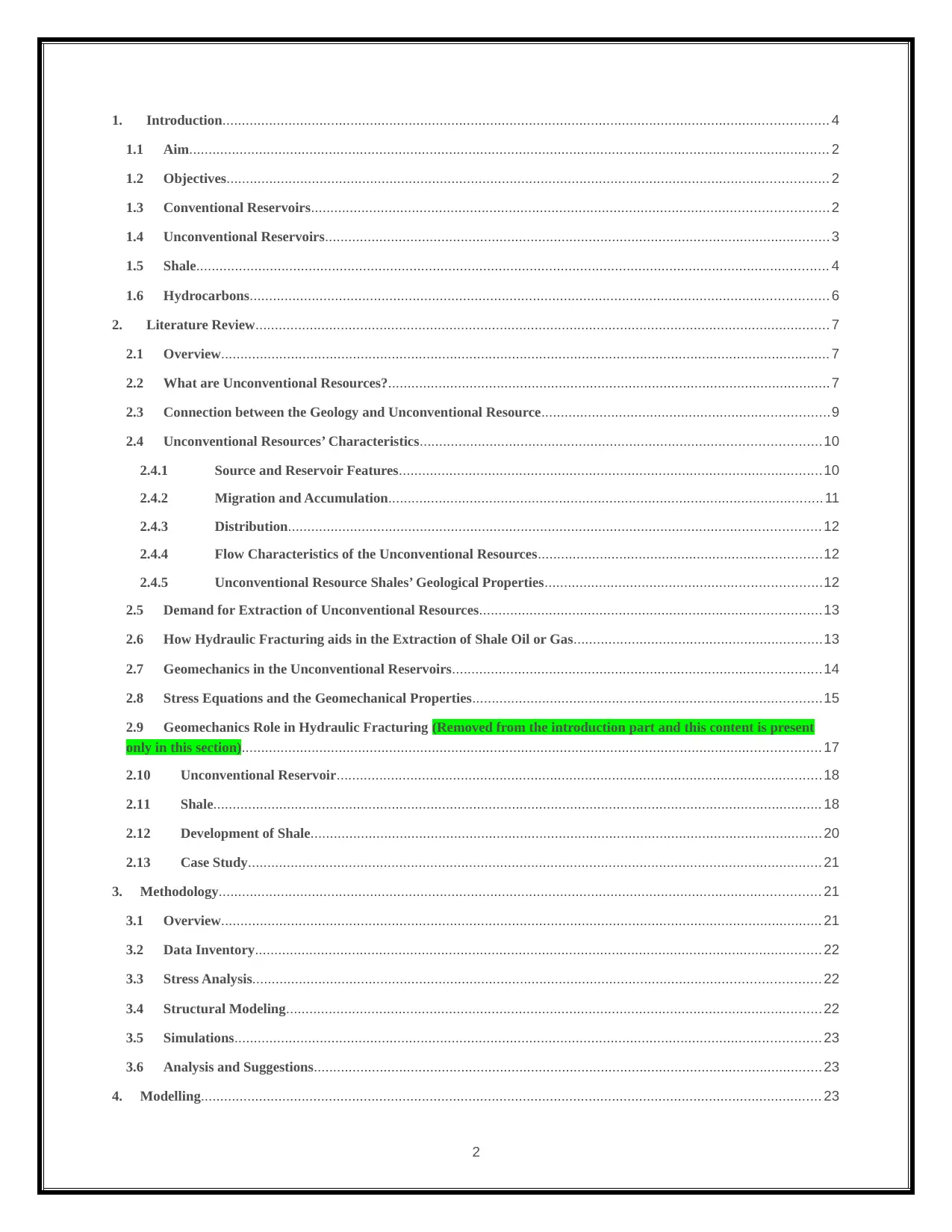
1. Introduction............................................................................................................................................................ 4
1.1 Aim..................................................................................................................................................................... 2
1.2 Objectives........................................................................................................................................................... 2
1.3 Conventional Reservoirs..................................................................................................................................... 2
1.4 Unconventional Reservoirs..................................................................................................................................3
1.5 Shale................................................................................................................................................................... 4
1.6 Hydrocarbons..................................................................................................................................................... 6
2. Literature Review.................................................................................................................................................... 7
2.1 Overview............................................................................................................................................................. 7
2.2 What are Unconventional Resources?..................................................................................................................7
2.3 Connection between the Geology and Unconventional Resource..........................................................................9
2.4 Unconventional Resources’ Characteristics.......................................................................................................10
2.4.1 Source and Reservoir Features.............................................................................................................10
2.4.2 Migration and Accumulation................................................................................................................11
2.4.3 Distribution......................................................................................................................................... 12
2.4.4 Flow Characteristics of the Unconventional Resources.........................................................................12
2.4.5 Unconventional Resource Shales’ Geological Properties.......................................................................12
2.5 Demand for Extraction of Unconventional Resources........................................................................................13
2.6 How Hydraulic Fracturing aids in the Extraction of Shale Oil or Gas................................................................13
2.7 Geomechanics in the Unconventional Reservoirs...............................................................................................14
2.8 Stress Equations and the Geomechanical Properties..........................................................................................15
2.9 Geomechanics Role in Hydraulic Fracturing (Removed from the introduction part and this content is present
only in this section)..................................................................................................................................................... 17
2.10 Unconventional Reservoir.............................................................................................................................18
2.11 Shale............................................................................................................................................................. 18
2.12 Development of Shale.................................................................................................................................... 20
2.13 Case Study.................................................................................................................................................... 21
3. Methodology........................................................................................................................................................... 21
3.1 Overview........................................................................................................................................................... 21
3.2 Data Inventory.................................................................................................................................................. 22
3.3 Stress Analysis.................................................................................................................................................. 22
3.4 Structural Modeling.......................................................................................................................................... 22
3.5 Simulations....................................................................................................................................................... 23
3.6 Analysis and Suggestions................................................................................................................................... 23
4. Modelling................................................................................................................................................................ 23
2
1.1 Aim..................................................................................................................................................................... 2
1.2 Objectives........................................................................................................................................................... 2
1.3 Conventional Reservoirs..................................................................................................................................... 2
1.4 Unconventional Reservoirs..................................................................................................................................3
1.5 Shale................................................................................................................................................................... 4
1.6 Hydrocarbons..................................................................................................................................................... 6
2. Literature Review.................................................................................................................................................... 7
2.1 Overview............................................................................................................................................................. 7
2.2 What are Unconventional Resources?..................................................................................................................7
2.3 Connection between the Geology and Unconventional Resource..........................................................................9
2.4 Unconventional Resources’ Characteristics.......................................................................................................10
2.4.1 Source and Reservoir Features.............................................................................................................10
2.4.2 Migration and Accumulation................................................................................................................11
2.4.3 Distribution......................................................................................................................................... 12
2.4.4 Flow Characteristics of the Unconventional Resources.........................................................................12
2.4.5 Unconventional Resource Shales’ Geological Properties.......................................................................12
2.5 Demand for Extraction of Unconventional Resources........................................................................................13
2.6 How Hydraulic Fracturing aids in the Extraction of Shale Oil or Gas................................................................13
2.7 Geomechanics in the Unconventional Reservoirs...............................................................................................14
2.8 Stress Equations and the Geomechanical Properties..........................................................................................15
2.9 Geomechanics Role in Hydraulic Fracturing (Removed from the introduction part and this content is present
only in this section)..................................................................................................................................................... 17
2.10 Unconventional Reservoir.............................................................................................................................18
2.11 Shale............................................................................................................................................................. 18
2.12 Development of Shale.................................................................................................................................... 20
2.13 Case Study.................................................................................................................................................... 21
3. Methodology........................................................................................................................................................... 21
3.1 Overview........................................................................................................................................................... 21
3.2 Data Inventory.................................................................................................................................................. 22
3.3 Stress Analysis.................................................................................................................................................. 22
3.4 Structural Modeling.......................................................................................................................................... 22
3.5 Simulations....................................................................................................................................................... 23
3.6 Analysis and Suggestions................................................................................................................................... 23
4. Modelling................................................................................................................................................................ 23
2
⊘ This is a preview!⊘
Do you want full access?
Subscribe today to unlock all pages.

Trusted by 1+ million students worldwide
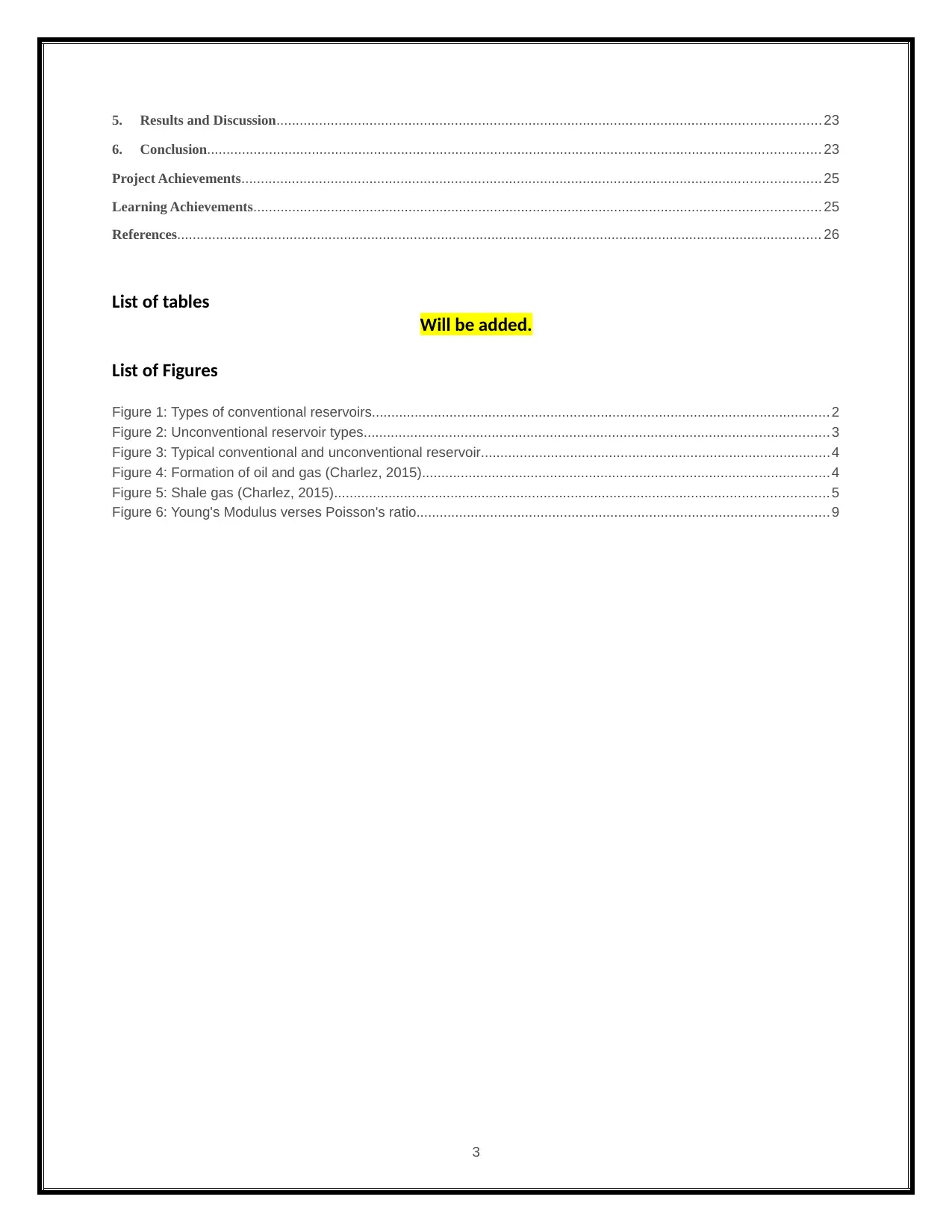
5. Results and Discussion............................................................................................................................................ 23
6. Conclusion.............................................................................................................................................................. 23
Project Achievements..................................................................................................................................................... 25
Learning Achievements.................................................................................................................................................. 25
References...................................................................................................................................................................... 26
List of tables
Will be added.
List of Figures
Figure 1: Types of conventional reservoirs...................................................................................................................... 2
Figure 2: Unconventional reservoir types........................................................................................................................3
Figure 3: Typical conventional and unconventional reservoir..........................................................................................4
Figure 4: Formation of oil and gas (Charlez, 2015).........................................................................................................4
Figure 5: Shale gas (Charlez, 2015)...............................................................................................................................5
Figure 6: Young's Modulus verses Poisson's ratio..........................................................................................................9
3
6. Conclusion.............................................................................................................................................................. 23
Project Achievements..................................................................................................................................................... 25
Learning Achievements.................................................................................................................................................. 25
References...................................................................................................................................................................... 26
List of tables
Will be added.
List of Figures
Figure 1: Types of conventional reservoirs...................................................................................................................... 2
Figure 2: Unconventional reservoir types........................................................................................................................3
Figure 3: Typical conventional and unconventional reservoir..........................................................................................4
Figure 4: Formation of oil and gas (Charlez, 2015).........................................................................................................4
Figure 5: Shale gas (Charlez, 2015)...............................................................................................................................5
Figure 6: Young's Modulus verses Poisson's ratio..........................................................................................................9
3
Paraphrase This Document
Need a fresh take? Get an instant paraphrase of this document with our AI Paraphraser
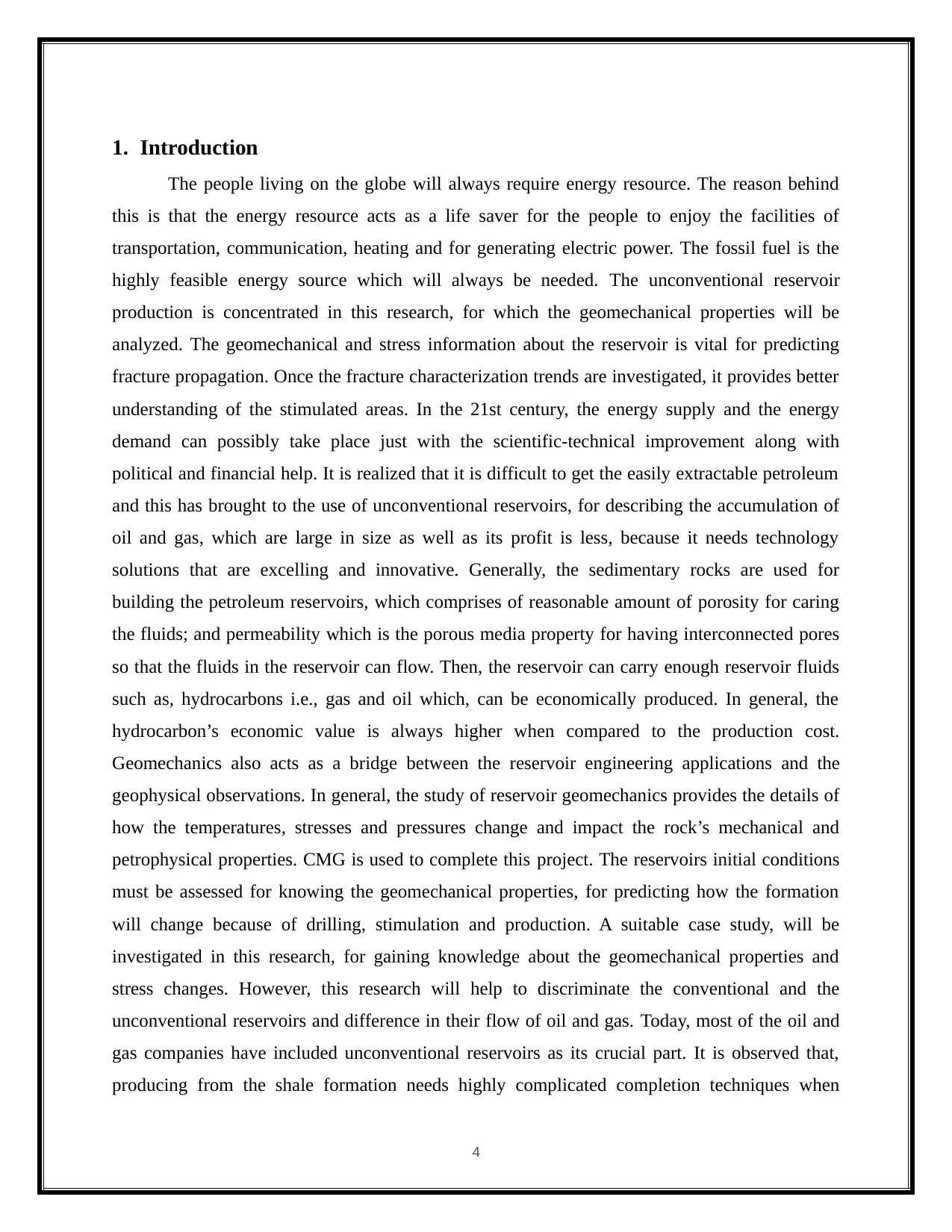
1. Introduction
The people living on the globe will always require energy resource. The reason behind
this is that the energy resource acts as a life saver for the people to enjoy the facilities of
transportation, communication, heating and for generating electric power. The fossil fuel is the
highly feasible energy source which will always be needed. The unconventional reservoir
production is concentrated in this research, for which the geomechanical properties will be
analyzed. The geomechanical and stress information about the reservoir is vital for predicting
fracture propagation. Once the fracture characterization trends are investigated, it provides better
understanding of the stimulated areas. In the 21st century, the energy supply and the energy
demand can possibly take place just with the scientific-technical improvement along with
political and financial help. It is realized that it is difficult to get the easily extractable petroleum
and this has brought to the use of unconventional reservoirs, for describing the accumulation of
oil and gas, which are large in size as well as its profit is less, because it needs technology
solutions that are excelling and innovative. Generally, the sedimentary rocks are used for
building the petroleum reservoirs, which comprises of reasonable amount of porosity for caring
the fluids; and permeability which is the porous media property for having interconnected pores
so that the fluids in the reservoir can flow. Then, the reservoir can carry enough reservoir fluids
such as, hydrocarbons i.e., gas and oil which, can be economically produced. In general, the
hydrocarbon’s economic value is always higher when compared to the production cost.
Geomechanics also acts as a bridge between the reservoir engineering applications and the
geophysical observations. In general, the study of reservoir geomechanics provides the details of
how the temperatures, stresses and pressures change and impact the rock’s mechanical and
petrophysical properties. CMG is used to complete this project. The reservoirs initial conditions
must be assessed for knowing the geomechanical properties, for predicting how the formation
will change because of drilling, stimulation and production. A suitable case study, will be
investigated in this research, for gaining knowledge about the geomechanical properties and
stress changes. However, this research will help to discriminate the conventional and the
unconventional reservoirs and difference in their flow of oil and gas. Today, most of the oil and
gas companies have included unconventional reservoirs as its crucial part. It is observed that,
producing from the shale formation needs highly complicated completion techniques when
4
The people living on the globe will always require energy resource. The reason behind
this is that the energy resource acts as a life saver for the people to enjoy the facilities of
transportation, communication, heating and for generating electric power. The fossil fuel is the
highly feasible energy source which will always be needed. The unconventional reservoir
production is concentrated in this research, for which the geomechanical properties will be
analyzed. The geomechanical and stress information about the reservoir is vital for predicting
fracture propagation. Once the fracture characterization trends are investigated, it provides better
understanding of the stimulated areas. In the 21st century, the energy supply and the energy
demand can possibly take place just with the scientific-technical improvement along with
political and financial help. It is realized that it is difficult to get the easily extractable petroleum
and this has brought to the use of unconventional reservoirs, for describing the accumulation of
oil and gas, which are large in size as well as its profit is less, because it needs technology
solutions that are excelling and innovative. Generally, the sedimentary rocks are used for
building the petroleum reservoirs, which comprises of reasonable amount of porosity for caring
the fluids; and permeability which is the porous media property for having interconnected pores
so that the fluids in the reservoir can flow. Then, the reservoir can carry enough reservoir fluids
such as, hydrocarbons i.e., gas and oil which, can be economically produced. In general, the
hydrocarbon’s economic value is always higher when compared to the production cost.
Geomechanics also acts as a bridge between the reservoir engineering applications and the
geophysical observations. In general, the study of reservoir geomechanics provides the details of
how the temperatures, stresses and pressures change and impact the rock’s mechanical and
petrophysical properties. CMG is used to complete this project. The reservoirs initial conditions
must be assessed for knowing the geomechanical properties, for predicting how the formation
will change because of drilling, stimulation and production. A suitable case study, will be
investigated in this research, for gaining knowledge about the geomechanical properties and
stress changes. However, this research will help to discriminate the conventional and the
unconventional reservoirs and difference in their flow of oil and gas. Today, most of the oil and
gas companies have included unconventional reservoirs as its crucial part. It is observed that,
producing from the shale formation needs highly complicated completion techniques when
4
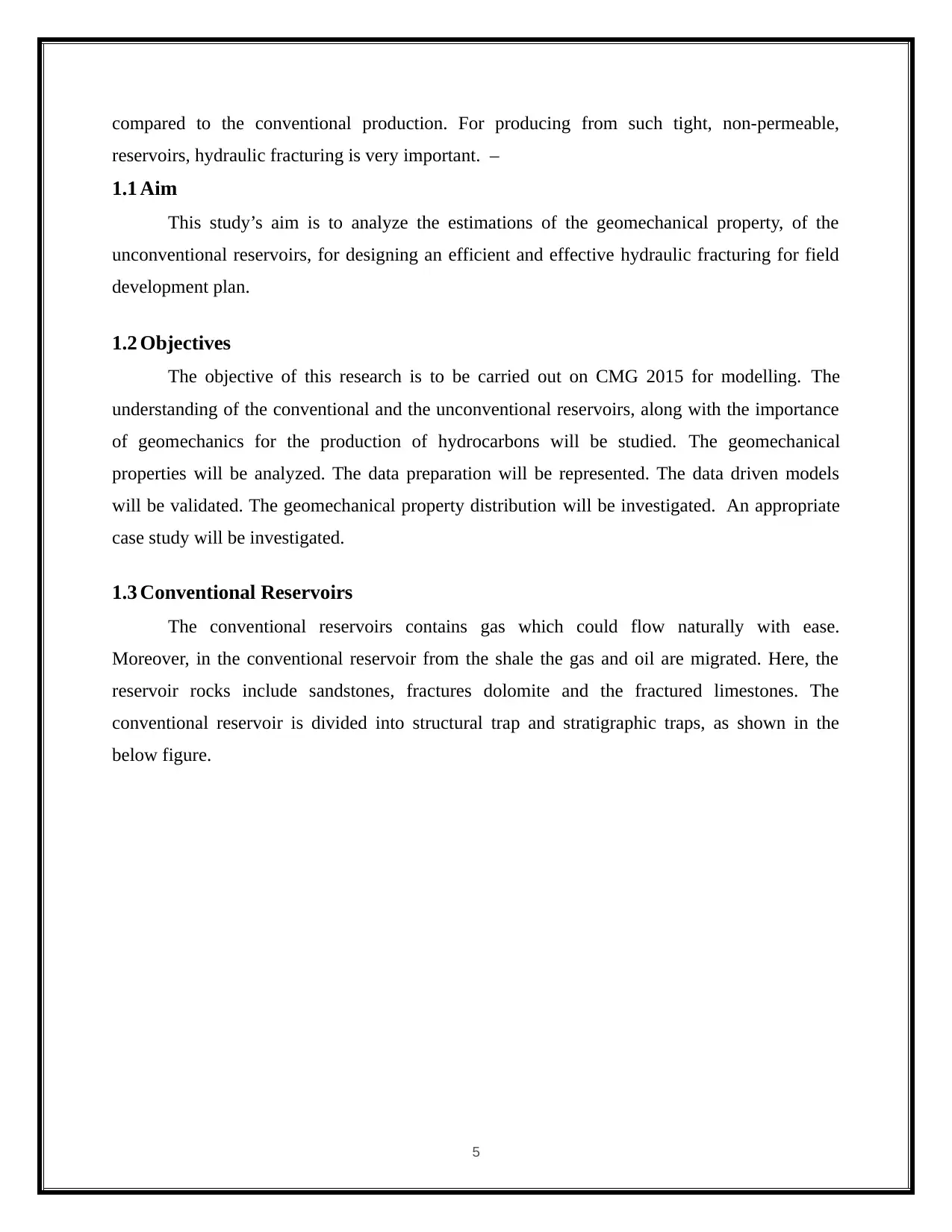
compared to the conventional production. For producing from such tight, non-permeable,
reservoirs, hydraulic fracturing is very important. –
1.1 Aim
This study’s aim is to analyze the estimations of the geomechanical property, of the
unconventional reservoirs, for designing an efficient and effective hydraulic fracturing for field
development plan.
1.2 Objectives
The objective of this research is to be carried out on CMG 2015 for modelling. The
understanding of the conventional and the unconventional reservoirs, along with the importance
of geomechanics for the production of hydrocarbons will be studied. The geomechanical
properties will be analyzed. The data preparation will be represented. The data driven models
will be validated. The geomechanical property distribution will be investigated. An appropriate
case study will be investigated.
1.3 Conventional Reservoirs
The conventional reservoirs contains gas which could flow naturally with ease.
Moreover, in the conventional reservoir from the shale the gas and oil are migrated. Here, the
reservoir rocks include sandstones, fractures dolomite and the fractured limestones. The
conventional reservoir is divided into structural trap and stratigraphic traps, as shown in the
below figure.
5
reservoirs, hydraulic fracturing is very important. –
1.1 Aim
This study’s aim is to analyze the estimations of the geomechanical property, of the
unconventional reservoirs, for designing an efficient and effective hydraulic fracturing for field
development plan.
1.2 Objectives
The objective of this research is to be carried out on CMG 2015 for modelling. The
understanding of the conventional and the unconventional reservoirs, along with the importance
of geomechanics for the production of hydrocarbons will be studied. The geomechanical
properties will be analyzed. The data preparation will be represented. The data driven models
will be validated. The geomechanical property distribution will be investigated. An appropriate
case study will be investigated.
1.3 Conventional Reservoirs
The conventional reservoirs contains gas which could flow naturally with ease.
Moreover, in the conventional reservoir from the shale the gas and oil are migrated. Here, the
reservoir rocks include sandstones, fractures dolomite and the fractured limestones. The
conventional reservoir is divided into structural trap and stratigraphic traps, as shown in the
below figure.
5
⊘ This is a preview!⊘
Do you want full access?
Subscribe today to unlock all pages.

Trusted by 1+ million students worldwide
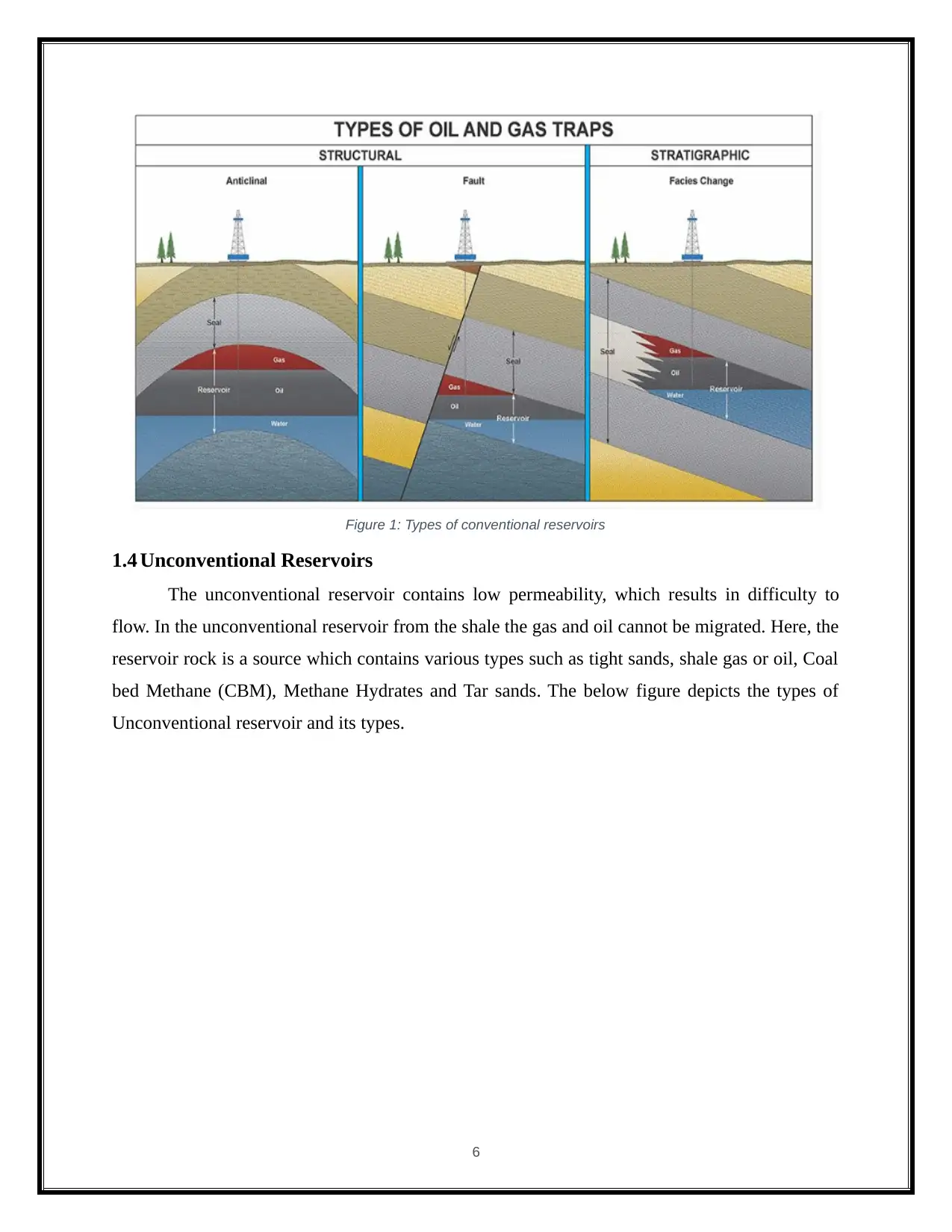
Figure 1: Types of conventional reservoirs
1.4 Unconventional Reservoirs
The unconventional reservoir contains low permeability, which results in difficulty to
flow. In the unconventional reservoir from the shale the gas and oil cannot be migrated. Here, the
reservoir rock is a source which contains various types such as tight sands, shale gas or oil, Coal
bed Methane (CBM), Methane Hydrates and Tar sands. The below figure depicts the types of
Unconventional reservoir and its types.
6
1.4 Unconventional Reservoirs
The unconventional reservoir contains low permeability, which results in difficulty to
flow. In the unconventional reservoir from the shale the gas and oil cannot be migrated. Here, the
reservoir rock is a source which contains various types such as tight sands, shale gas or oil, Coal
bed Methane (CBM), Methane Hydrates and Tar sands. The below figure depicts the types of
Unconventional reservoir and its types.
6
Paraphrase This Document
Need a fresh take? Get an instant paraphrase of this document with our AI Paraphraser
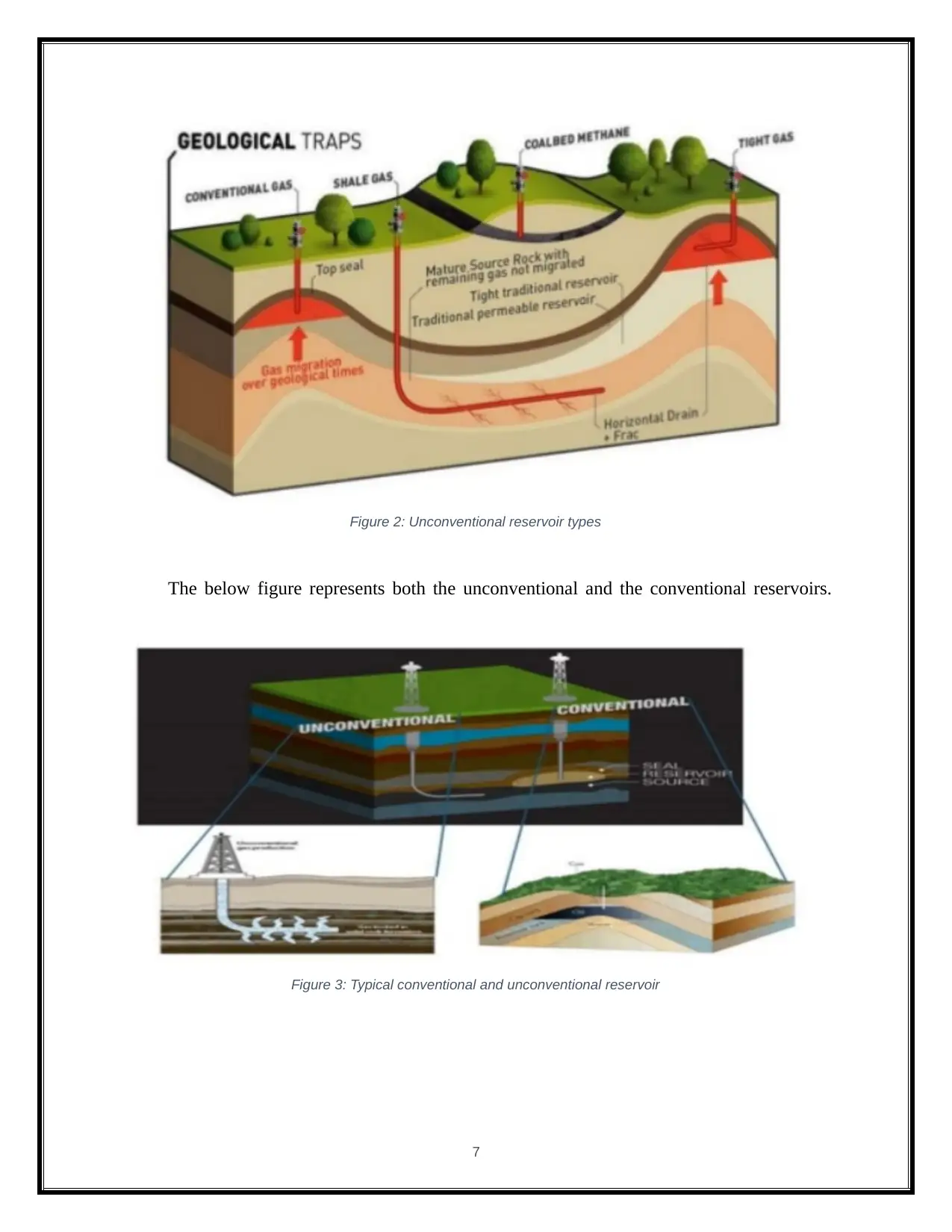
Figure 2: Unconventional reservoir types
The below figure represents both the unconventional and the conventional reservoirs.
Figure 3: Typical conventional and unconventional reservoir
7
The below figure represents both the unconventional and the conventional reservoirs.
Figure 3: Typical conventional and unconventional reservoir
7
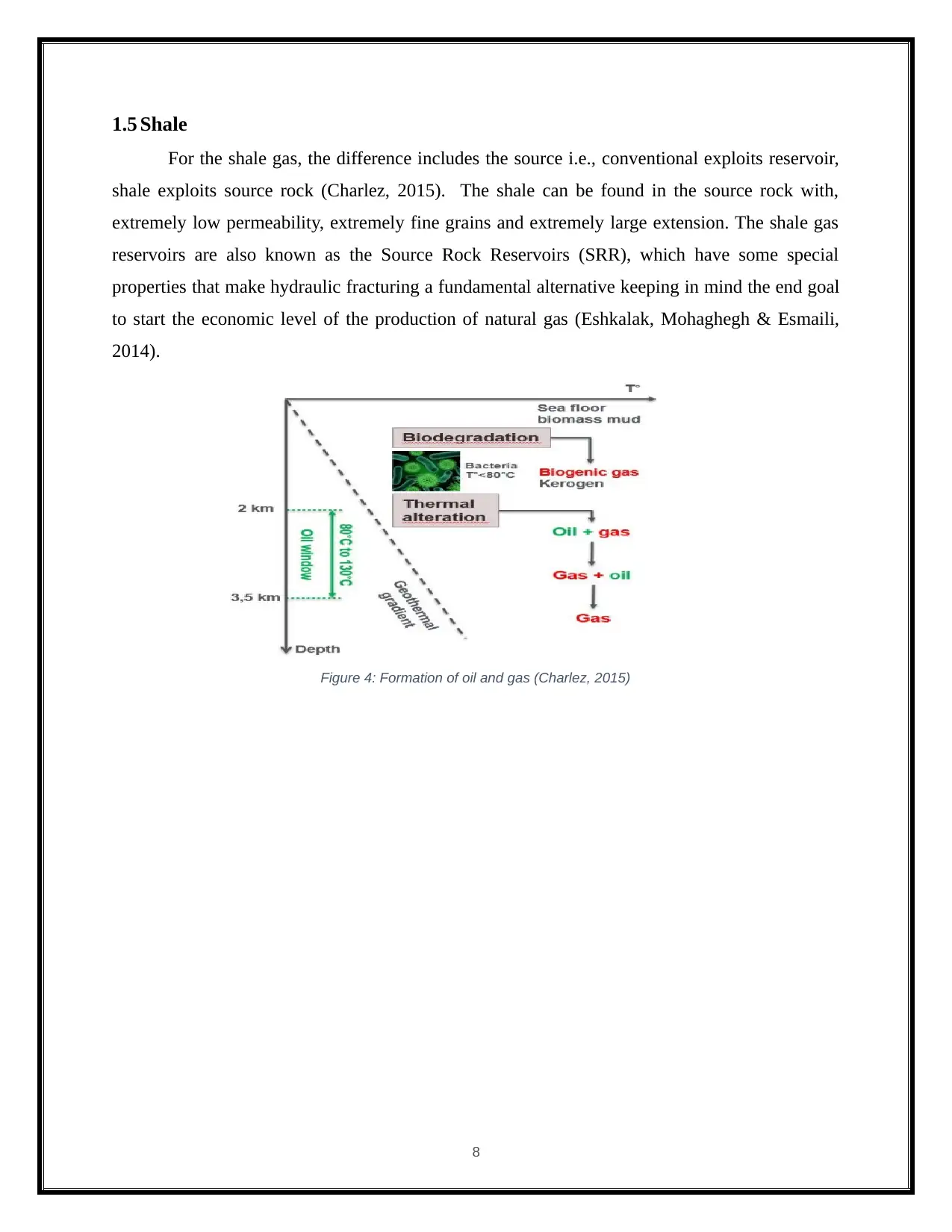
1.5 Shale
For the shale gas, the difference includes the source i.e., conventional exploits reservoir,
shale exploits source rock (Charlez, 2015). The shale can be found in the source rock with,
extremely low permeability, extremely fine grains and extremely large extension. The shale gas
reservoirs are also known as the Source Rock Reservoirs (SRR), which have some special
properties that make hydraulic fracturing a fundamental alternative keeping in mind the end goal
to start the economic level of the production of natural gas (Eshkalak, Mohaghegh & Esmaili,
2014).
Figure 4: Formation of oil and gas (Charlez, 2015)
8
For the shale gas, the difference includes the source i.e., conventional exploits reservoir,
shale exploits source rock (Charlez, 2015). The shale can be found in the source rock with,
extremely low permeability, extremely fine grains and extremely large extension. The shale gas
reservoirs are also known as the Source Rock Reservoirs (SRR), which have some special
properties that make hydraulic fracturing a fundamental alternative keeping in mind the end goal
to start the economic level of the production of natural gas (Eshkalak, Mohaghegh & Esmaili,
2014).
Figure 4: Formation of oil and gas (Charlez, 2015)
8
⊘ This is a preview!⊘
Do you want full access?
Subscribe today to unlock all pages.

Trusted by 1+ million students worldwide
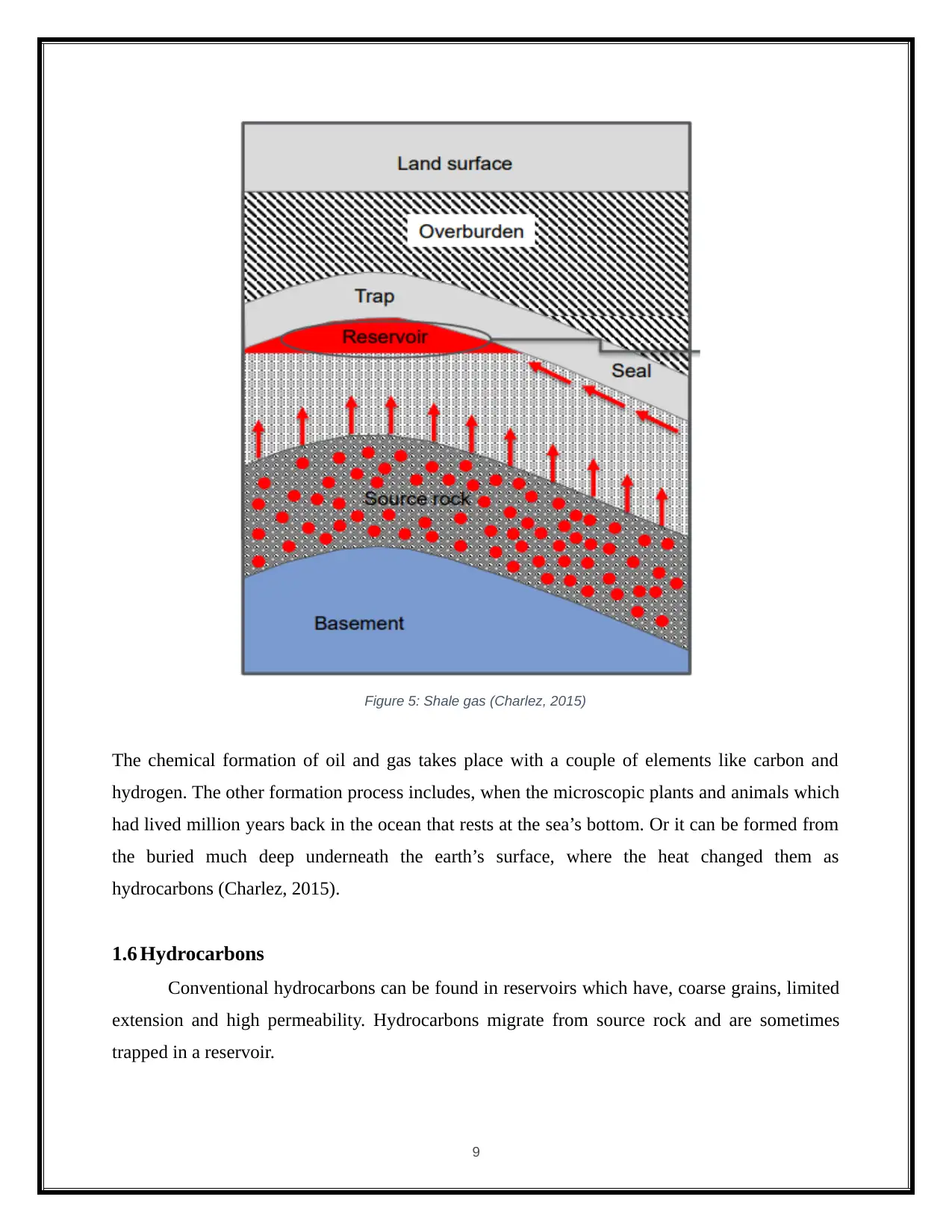
Figure 5: Shale gas (Charlez, 2015)
The chemical formation of oil and gas takes place with a couple of elements like carbon and
hydrogen. The other formation process includes, when the microscopic plants and animals which
had lived million years back in the ocean that rests at the sea’s bottom. Or it can be formed from
the buried much deep underneath the earth’s surface, where the heat changed them as
hydrocarbons (Charlez, 2015).
1.6 Hydrocarbons
Conventional hydrocarbons can be found in reservoirs which have, coarse grains, limited
extension and high permeability. Hydrocarbons migrate from source rock and are sometimes
trapped in a reservoir.
9
The chemical formation of oil and gas takes place with a couple of elements like carbon and
hydrogen. The other formation process includes, when the microscopic plants and animals which
had lived million years back in the ocean that rests at the sea’s bottom. Or it can be formed from
the buried much deep underneath the earth’s surface, where the heat changed them as
hydrocarbons (Charlez, 2015).
1.6 Hydrocarbons
Conventional hydrocarbons can be found in reservoirs which have, coarse grains, limited
extension and high permeability. Hydrocarbons migrate from source rock and are sometimes
trapped in a reservoir.
9
Paraphrase This Document
Need a fresh take? Get an instant paraphrase of this document with our AI Paraphraser
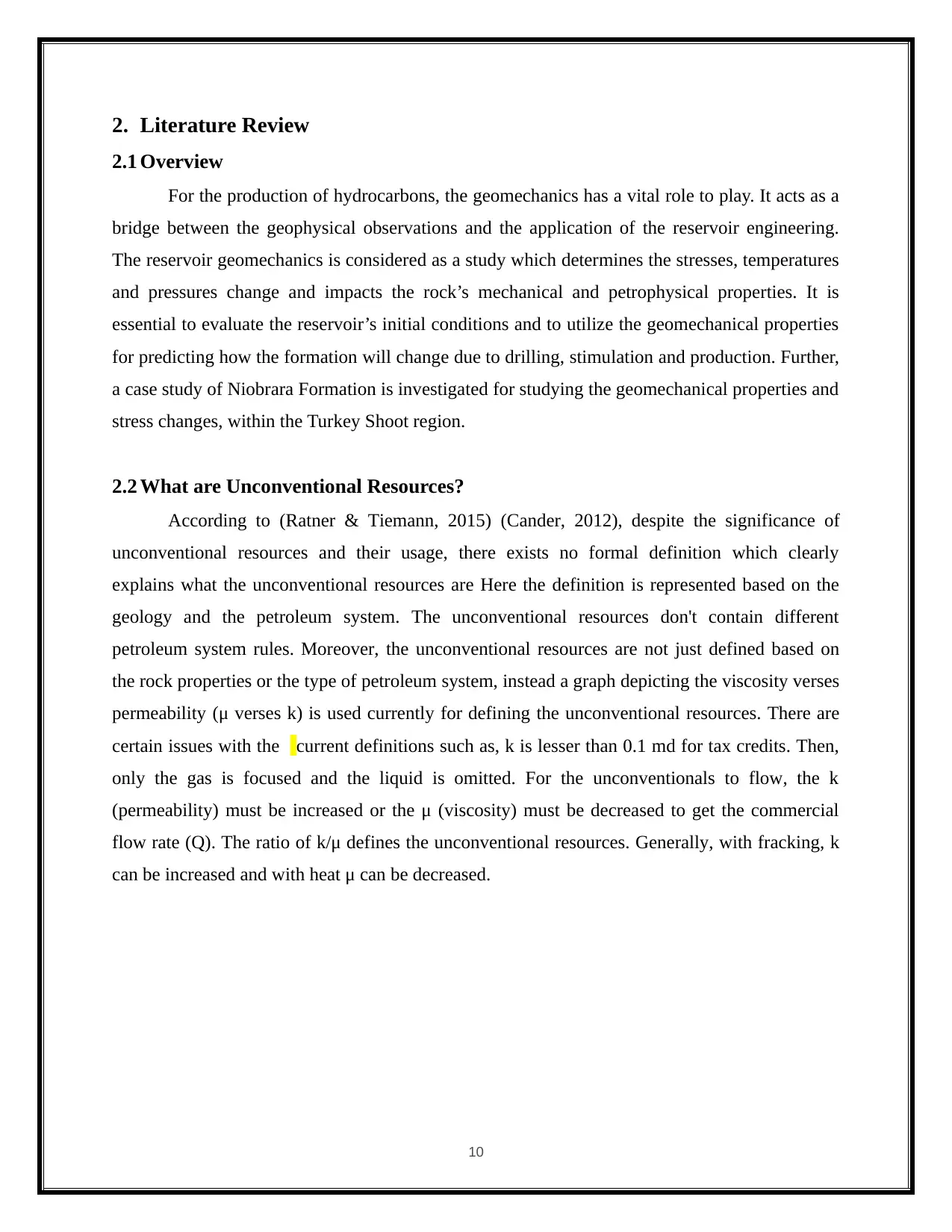
2. Literature Review
2.1 Overview
For the production of hydrocarbons, the geomechanics has a vital role to play. It acts as a
bridge between the geophysical observations and the application of the reservoir engineering.
The reservoir geomechanics is considered as a study which determines the stresses, temperatures
and pressures change and impacts the rock’s mechanical and petrophysical properties. It is
essential to evaluate the reservoir’s initial conditions and to utilize the geomechanical properties
for predicting how the formation will change due to drilling, stimulation and production. Further,
a case study of Niobrara Formation is investigated for studying the geomechanical properties and
stress changes, within the Turkey Shoot region.
2.2 What are Unconventional Resources?
According to (Ratner & Tiemann, 2015) (Cander, 2012), despite the significance of
unconventional resources and their usage, there exists no formal definition which clearly
explains what the unconventional resources are Here the definition is represented based on the
geology and the petroleum system. The unconventional resources don't contain different
petroleum system rules. Moreover, the unconventional resources are not just defined based on
the rock properties or the type of petroleum system, instead a graph depicting the viscosity verses
permeability (μ verses k) is used currently for defining the unconventional resources. There are
certain issues with the current definitions such as, k is lesser than 0.1 md for tax credits. Then,
only the gas is focused and the liquid is omitted. For the unconventionals to flow, the k
(permeability) must be increased or the μ (viscosity) must be decreased to get the commercial
flow rate (Q). The ratio of k/μ defines the unconventional resources. Generally, with fracking, k
can be increased and with heat μ can be decreased.
10
2.1 Overview
For the production of hydrocarbons, the geomechanics has a vital role to play. It acts as a
bridge between the geophysical observations and the application of the reservoir engineering.
The reservoir geomechanics is considered as a study which determines the stresses, temperatures
and pressures change and impacts the rock’s mechanical and petrophysical properties. It is
essential to evaluate the reservoir’s initial conditions and to utilize the geomechanical properties
for predicting how the formation will change due to drilling, stimulation and production. Further,
a case study of Niobrara Formation is investigated for studying the geomechanical properties and
stress changes, within the Turkey Shoot region.
2.2 What are Unconventional Resources?
According to (Ratner & Tiemann, 2015) (Cander, 2012), despite the significance of
unconventional resources and their usage, there exists no formal definition which clearly
explains what the unconventional resources are Here the definition is represented based on the
geology and the petroleum system. The unconventional resources don't contain different
petroleum system rules. Moreover, the unconventional resources are not just defined based on
the rock properties or the type of petroleum system, instead a graph depicting the viscosity verses
permeability (μ verses k) is used currently for defining the unconventional resources. There are
certain issues with the current definitions such as, k is lesser than 0.1 md for tax credits. Then,
only the gas is focused and the liquid is omitted. For the unconventionals to flow, the k
(permeability) must be increased or the μ (viscosity) must be decreased to get the commercial
flow rate (Q). The ratio of k/μ defines the unconventional resources. Generally, with fracking, k
can be increased and with heat μ can be decreased.
10
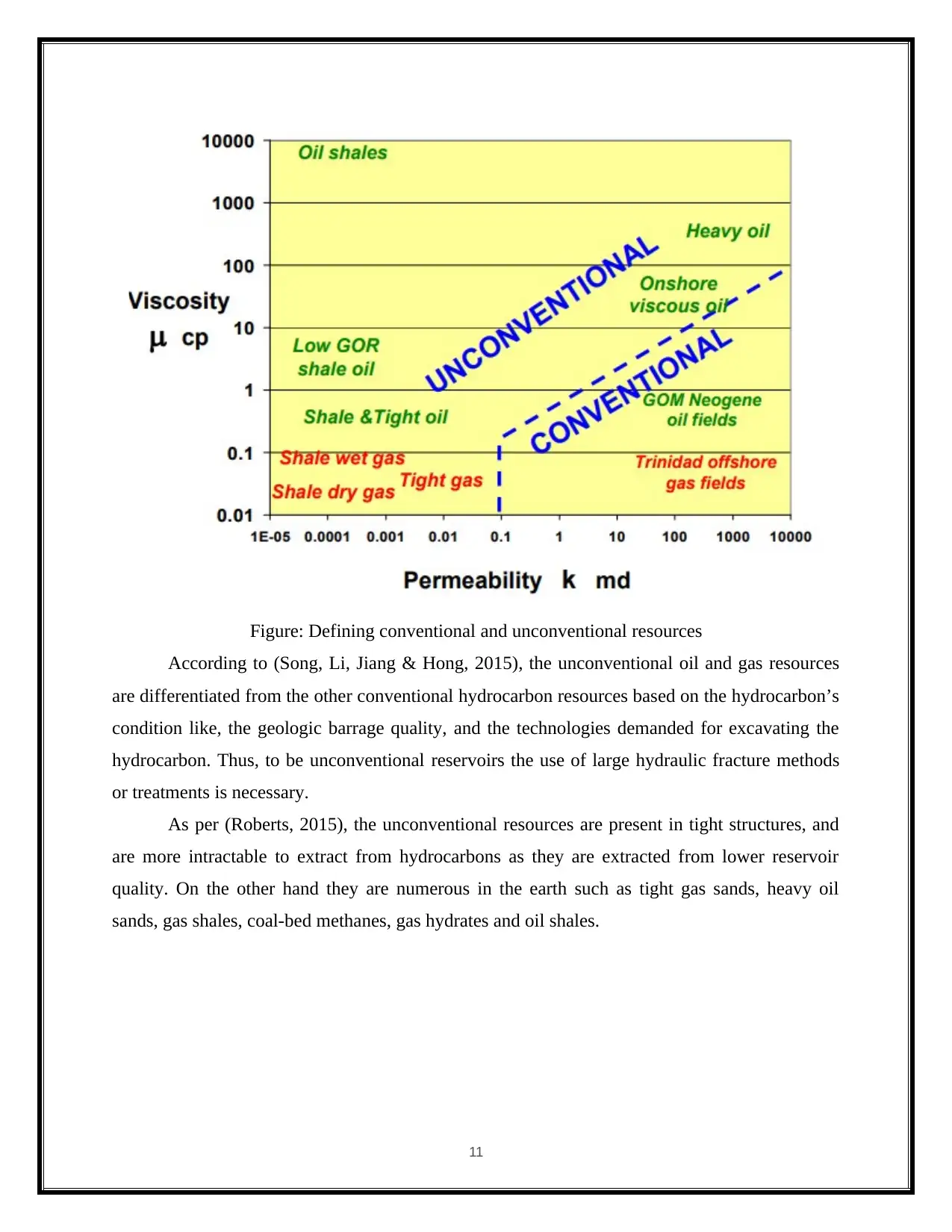
Figure: Defining conventional and unconventional resources
According to (Song, Li, Jiang & Hong, 2015), the unconventional oil and gas resources
are differentiated from the other conventional hydrocarbon resources based on the hydrocarbon’s
condition like, the geologic barrage quality, and the technologies demanded for excavating the
hydrocarbon. Thus, to be unconventional reservoirs the use of large hydraulic fracture methods
or treatments is necessary.
As per (Roberts, 2015), the unconventional resources are present in tight structures, and
are more intractable to extract from hydrocarbons as they are extracted from lower reservoir
quality. On the other hand they are numerous in the earth such as tight gas sands, heavy oil
sands, gas shales, coal-bed methanes, gas hydrates and oil shales.
11
According to (Song, Li, Jiang & Hong, 2015), the unconventional oil and gas resources
are differentiated from the other conventional hydrocarbon resources based on the hydrocarbon’s
condition like, the geologic barrage quality, and the technologies demanded for excavating the
hydrocarbon. Thus, to be unconventional reservoirs the use of large hydraulic fracture methods
or treatments is necessary.
As per (Roberts, 2015), the unconventional resources are present in tight structures, and
are more intractable to extract from hydrocarbons as they are extracted from lower reservoir
quality. On the other hand they are numerous in the earth such as tight gas sands, heavy oil
sands, gas shales, coal-bed methanes, gas hydrates and oil shales.
11
⊘ This is a preview!⊘
Do you want full access?
Subscribe today to unlock all pages.

Trusted by 1+ million students worldwide
1 out of 31
Related Documents
Your All-in-One AI-Powered Toolkit for Academic Success.
+13062052269
info@desklib.com
Available 24*7 on WhatsApp / Email
![[object Object]](/_next/static/media/star-bottom.7253800d.svg)
Unlock your academic potential
Copyright © 2020–2025 A2Z Services. All Rights Reserved. Developed and managed by ZUCOL.





